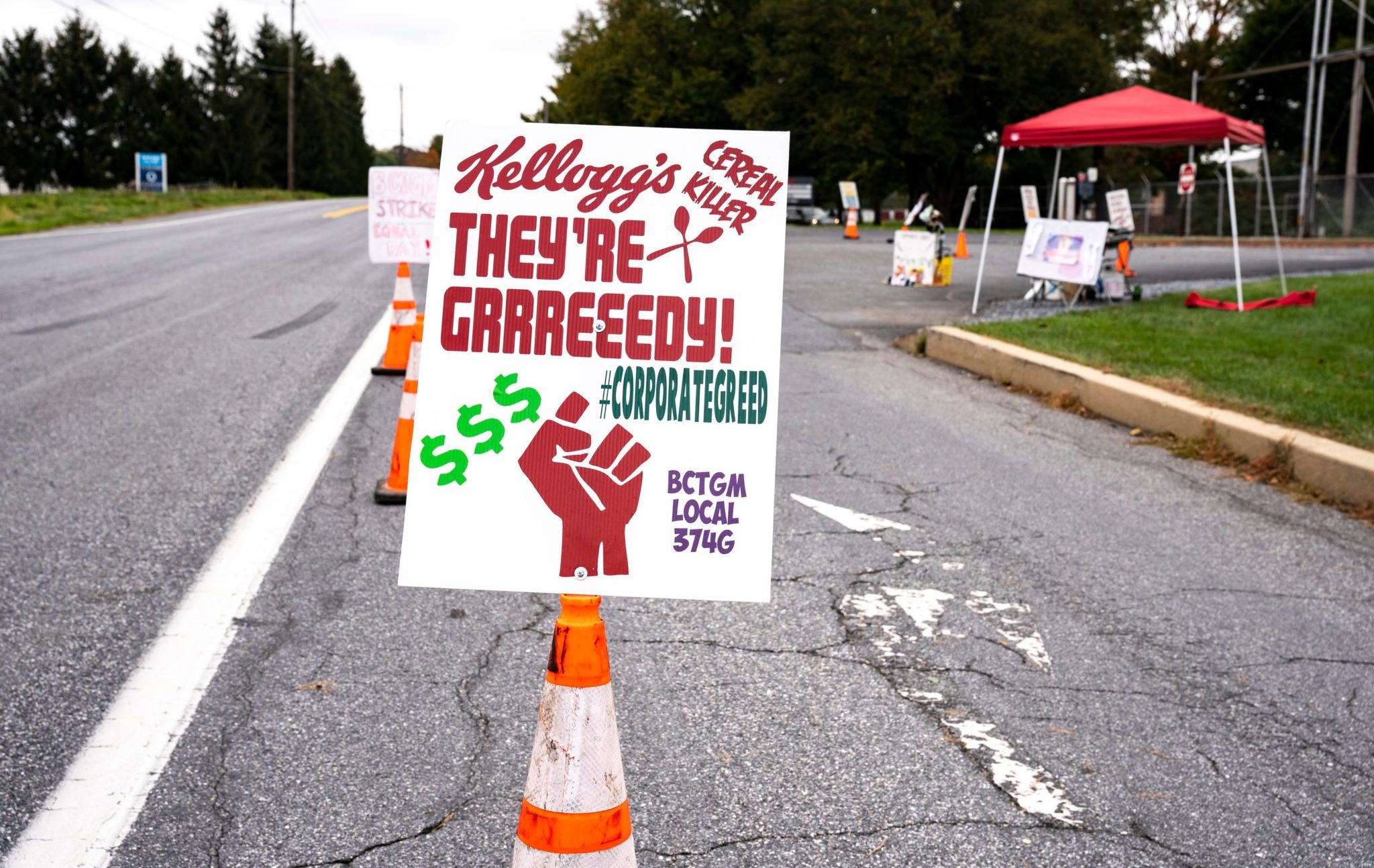The Striking Story of the Year

From the critical race theory wars to the ugly Afghan exit, and from “1/6” to the GOP’s suburban comeback, 2021 was an eventful year, to put it mildly. Yet for my money, the year’s most important, and underreported, story was the militant mood roiling the working class—a development with the potential to reshape the American political economy, and our politics, for years to come.
The latest flashpoint came in Battle Creek, Michigan, where last week Sen. Bernie Sanders joined striking cereal workers on the picket line at the local Kellogg’s plant. Some 1,400 workers at four plants, including the Battle Creek facility, have been on strike since their contract expired in October.
“If you love America, you love the workers ,” said the Vermont socialist. “And if you love American workers, you don’t ship their jobs”—a reference to Kellogg’s alleged threat to transfer some production below the southern border in response to the strikes; the firm strenuously denies making the threat. (Sanders’ message garnered a supportive retweet from Washington state GOP congressional candidate and friend of TAC Joe Kent.)
Meager raises and brutally long workdays—overtime is often mandatory, and workweeks can last up to 84 hours—are among the grievances. But it’s the two-tier employee regime that has proved the stickiest point of contention. At issue is nothing less than whether the next generation of American manufacturing workers gets to access anything close to the same degree of job security and middle-class stability enjoyed by their parents and grandparents.
Kellogg’s first instituted the tier system in 2015. As Stephen Rodrick reports for Rolling Stone, under the system, “veteran workers would keep ‘legacy status’ and their salaries and benefits, but new hires would…pay $300 more a month for their health benefits and would be paid an hourly rate as much as a third less than their more-senior union brothers and sisters.”
Kellogg’s preferred term for younger, second-tier employees: “transitional workers.” Baked into the corporate vernacular, in other words, is the notion that labor in the future is to be thought of as something impermanent, passing, disposable, insecure. As Rodrick puts it: “You will not enjoy the middle-class lifestyle that your parents did working on these very same machines. Well, unless you work 72 hours a week.”
The firm did offer to replace each retiring “legacy” worker with someone from the “transitional” ranks, but it also removed many job categories from the one-for-one advancement pipeline. Then, this year, despite $4 billion in gross profits, Kellogg’s contract offer would have made all new hires lower-tier. That bit of corporate effrontery triggered a strike that has now stretched close to three months.
Along the way, workers overwhelmingly rejected an agreement negotiated with the Bakery, Confectionery, Tobacco Workers and Grain Millers International Union that wouldn’t have ended the two-tier system. Another tentative agreement was reached last week, with the vote results expected Tuesday. Yet many rank-and-file members are wary that the union will continue to sell out younger members on the tier system.
As one veteran told the World Socialist Web Site, “This [new proposed] contract would make me lots of money and get me the four years I need to retire, but I don’t care about that right now. I’m sick of seeing the young people getting screwed. This is still not good for them. I’m voting NO.” (The WSWS often viciously criticizes Big Labor from the left; it also published some of the earliest and best debunkings of the New York Times’ 1619 Project.)
Something, in short, is happening with the American working class. As the University of Chicago labor historian Gabriel Winant observed in a recent essay on the “Strike Wave,” tangible toilers appear more energized than they have in a long time, owing to the “accumulated outrage at the workplace brutalities of the pandemic, plus increased working-class confidence and labor-market leverage.”
Still, though the ferment spans a wide range of industries, it is “a matter of only tens of thousands, not the millions of earlier episodes of US labour history,” Winant notes. The overwhelming share of workers in the private economy remain unorganized, and Big Labor’s combination of corruption, ineffectiveness, and pusillanimity before management means the balance of forces is unlikely to tilt anytime soon. Existing unions help manage the declining American working class while harnessing votes for a Democratic Party that counts corporate America as its real constituency.
The newly militant workers, in other words, form a bloc without a political vehicle. It remains to be seen whether the GOP’s pro-worker wing will take up the opportunity to serve as that instrument. Words aren’t enough, gentlemen.
Comments